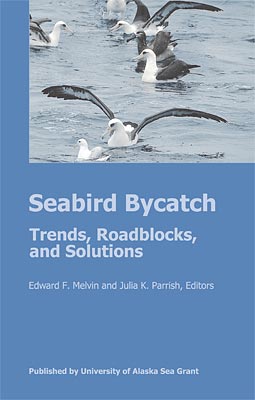
Novel tools to reduce seabird bycatch in coastal gillnet fisheries
E.F. Melvin, J.K. Parrish, and L.L. Conquest
- Price: $2.00 Sale: $0.00
 This is part of Seabird Bycatch: Trends, Roadblocks, and Solutions
This is part of Seabird Bycatch: Trends, Roadblocks, and Solutions| Format | Price | |
|---|---|---|
| PDF download [430.8 KB] Bypass cart and download |
Free | Add to Cart |
Description
We examined several strategies to reduce seabird bycatch, primarily of Common Murres (Uria aalge) and Rhinoceros Auklets (Cerorhinca monocerata), in a coastal salmon drift gillnet fishery in Puget Sound, Washington (USA). Our goal was a significant reduction in seabird bycatch without a concomitant reduction in target catch or an increase in the bycatch of any other species. We compared fish catch and seabird bycatch in nets modified to include visual alerts (highly visible netting in the upper net) or acoustic alerts (pingers) to traditional monofilament nets set throughout the normal fishing hours over a five-week fishing season. Catch and bycatch varied significantly as a function of gear. With monofilament controls, murres responded to both visual and acoustic alerts; auklets and sockeye salmon responded to deeper visual alerts only. Seabird abundance varied across multiple temporal scales: interannually, within fishing season, and within day. At the interannual level seabird entanglement was linked to regional abundance on the fishing grounds, a pattern which broke down at the local level. Within season, sockeye and murre abundance were negatively correlated, suggesting that if fishery openings were scheduled on peak abundance of the target species, seabird bycatch would be significantly reduced as a function of increased target fishing efficiency. Finally, both sockeye catch and auklet entanglement were highest at dawn, whereas murre entanglement was high at both dawn and dusk. Our results identify three complementary tools to reduce seabird bycatch in the Puget Sound drift gillnet fishery—gear modifications, abundance-based fishery openings, and time of day restrictions—for a possible reduction in seabird bycatch of up to 70-75% without a significant reduction in target fishing efficiency. Although these tools are based on local conditions and will thus vary among years and locations, all might be exportable to other coastal gillnet fisheries worldwide.
Item details
- Item number: AK-SG-01-01i
- Year: 2001
- DOI: https://doi.org/10.4027/sbtrs.2001.09



